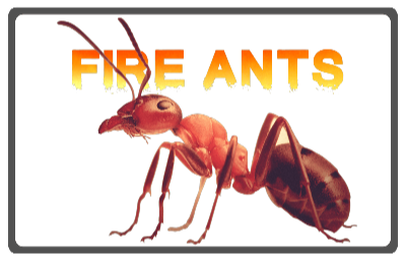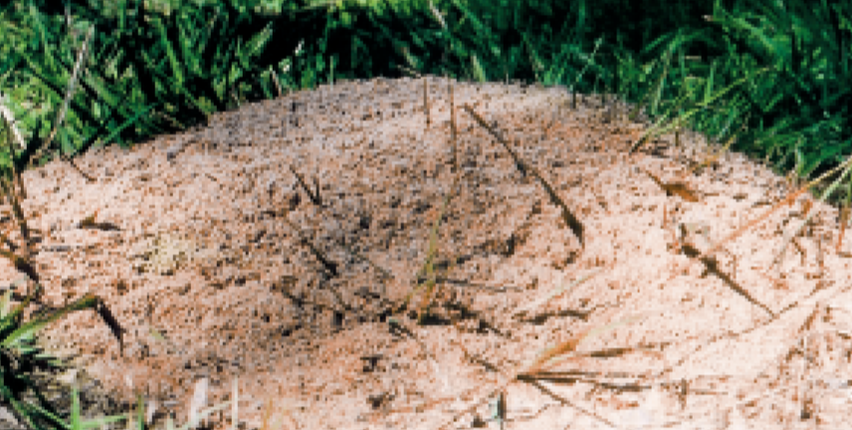Fire ants sting millions every year, triggering lawsuits, |
| Ask a group of Southerners about fire ants, and one will find most have had first-hand experience dealing with this stinging insect. While many Southerners may say they know all about fire ants, the results of a survey of consumers in the South demonstrates a clear need for updating and re-educating the public regarding these pests. We questioned individuals who were exiting local grocery stores and other shopping venues located in the suburban North Metro Atlanta area. We asked these people several yes/no questions regarding fire ants to ascertain what they knew about fire ants. |
When questioned “Are you familiar with fire ants?” all respondents answered that they are. This was not surprising given that 74 percent of the respondents have lived in the South for five years or more. Certainly, with this percentage of respondents living in the South at least five years, we might assume that they would have learned about fire ants the hard way — either by firsthand experience or knowing someone else who had been stung.
Yet, 93 percent of those surveyed said they were unaware that since fire ants were introduced into the United States about 80 human deaths have been attributed to the stinging insects. Common to these 80 cases was that they occurred outdoors, but more recently there have been what appears to be an increased number of RIFA incidents occurring indoors.
Many within the industry may have heard about cases regarding lawsuits due to fire ant-related incidents, but we seem to only hear about those cases that are litigated or publicized through the media. There are numerous other such cases that are settled out of court, so we never hear about them.
Yet, 93 percent of those surveyed said they were unaware that since fire ants were introduced into the United States about 80 human deaths have been attributed to the stinging insects. Common to these 80 cases was that they occurred outdoors, but more recently there have been what appears to be an increased number of RIFA incidents occurring indoors.
Many within the industry may have heard about cases regarding lawsuits due to fire ant-related incidents, but we seem to only hear about those cases that are litigated or publicized through the media. There are numerous other such cases that are settled out of court, so we never hear about them.
In September 1990, a four-day old infant was stung to death by RIFAs while sleeping in its crib in a southern state. Of special concern is that this particular case occurred in a second-floor bedroom, and it happened earlier than other previous, widely known cases. Often we hear of fire ant cases in commercial facilities such as health care, assisted living facilities or nursing homes, but such incidents can and do occur in residential settings as well
Hot Issue
While the spread of fire ants is well documented, only recently has data been collected by the medical community regarding the incidence of fire ant-related injury on a broad basis. It has been reported that more than 40 million people live in fire ant-infested geography in the southern United States.
A recent survey found an estimated 79 percent of Texans have been stung by fire ants. In a survey of more than 1,200 healthcare professionals in South Carolina, it was estimated that 33,000 people recently sought medical attention for fire ant stings, and 660 of these people were treated for anaphylaxis — a severe reaction, although relatively rare, reported to have caused the nearly 80 documented fire ant-related deaths in the United States.
A recent survey found an estimated 79 percent of Texans have been stung by fire ants. In a survey of more than 1,200 healthcare professionals in South Carolina, it was estimated that 33,000 people recently sought medical attention for fire ant stings, and 660 of these people were treated for anaphylaxis — a severe reaction, although relatively rare, reported to have caused the nearly 80 documented fire ant-related deaths in the United States.
Our industry has assembled a battery of facts regarding the damage potential of termites — a virtual arsenal of information familiar to well-trained technicians and termite sales executives. Nearly every piece of termite literature is full of such information.
For some reason, however, we have been remiss in collecting, disseminating and sharing such powerful information about potentially deadly RIFAs.
We formed a roundtable of 10 PMPs and asked them: “Knowing what you know about the hazard of fire ants and their ability to sting and potentially harm people, do you think the professional pest management industry should inform its customers about the hazard of fire ants?” (Please note this question clearly limited the call to action to just informing our customers about fire ants, not the general public.)
Nine of the 10 PMPs stated a resounding, “Yes.” While 90 percent of our roundtable of experts think the pest management industry should inform its customers about the hazard of fire ants, 100 percent of home owners questioned in our survey think the pest control industry should inform them regarding the hazard of fire ants, what they can do and ways to prevent and control infestations.
For some reason, however, we have been remiss in collecting, disseminating and sharing such powerful information about potentially deadly RIFAs.
We formed a roundtable of 10 PMPs and asked them: “Knowing what you know about the hazard of fire ants and their ability to sting and potentially harm people, do you think the professional pest management industry should inform its customers about the hazard of fire ants?” (Please note this question clearly limited the call to action to just informing our customers about fire ants, not the general public.)
Nine of the 10 PMPs stated a resounding, “Yes.” While 90 percent of our roundtable of experts think the pest management industry should inform its customers about the hazard of fire ants, 100 percent of home owners questioned in our survey think the pest control industry should inform them regarding the hazard of fire ants, what they can do and ways to prevent and control infestations.
Healthcare Settings
“Recommendations For Prevention and Management of
Fire Ant Infestation of Health Care Facilities”
published in the Southern Medical Journal outlines tips for controlling fire ants in healthcare facilities.
Fire Ant Infestation of Health Care Facilities”
published in the Southern Medical Journal outlines tips for controlling fire ants in healthcare facilities.
Tips Include
- Negotiate a contract with a pest management company providing monthly inspections of the grounds and the interior of all facilities, with treatment as required, and emergency service within 24 hours when requested. n Have staff conduct weekly inspections of the grounds and facilities.
- If fire ants are found within 25 feet of a building, notify the pest management company and require a perimeter treatment within 24 hours, with an on-site follow-up appointment by the provider one week later.
- If fire ants are found indoors, notify the pest management company and require a response within 24 hours. Document the extermination of fire ants in rooms and a post-treatment inspection of all facilities for active ant nests. Require daily inspections by the pest management company for one week.
The publication also includes a suggested treatment protocol for healthcare professionals if fire ants are found on a patient, recommendations for establishing and implementing facility fire-ant policy and developing and executing fire-ant prevention program protocols for both outdoor and indoor healthcare facilities.
While many initially think of commercial accounts when discussing fire ant activity, the fact is that the stinging insects are equal opportunity offenders. Historical record indicates that fire ants have caused serious injury in both commercial and residential accounts as well.
In either case, commercial or residential, there seems to be sufficient cause for the pest management industry to pay more-serious attention to our nation’s growing fire ant control problems. Our survey clearly indicates that most people do not know that fire ants can kill people or that the stinging insects have been responsible for at least 10 cases of attacks on humans indoors.
While many initially think of commercial accounts when discussing fire ant activity, the fact is that the stinging insects are equal opportunity offenders. Historical record indicates that fire ants have caused serious injury in both commercial and residential accounts as well.
In either case, commercial or residential, there seems to be sufficient cause for the pest management industry to pay more-serious attention to our nation’s growing fire ant control problems. Our survey clearly indicates that most people do not know that fire ants can kill people or that the stinging insects have been responsible for at least 10 cases of attacks on humans indoors.
Risk Management
Just as PMPs protect their customers from pests, where fire ants are concerned, PMPs need to be better prepared to best protect their businesses as well. The industry has seen numerous claims and litigation related to termites, but recently we have suffered an increasing number of fire-ant-related cases, and some of these cases have resulted in multi-million dollar awards and settlements.
PMPs who provide fire ant control services can protect their business interests by: eliminating fire ants from their general pest service contracts; using a separate contract for fire ant services; and upgrading their fire ant service protocols. their fire ant service protocols.
The elimination of fire ants from a general pest service contract is necessary for a number of reasons. One of the most important reasons is that by having a separate fire ant service contract, PMPs can include special language that supports the fire ant service protocols and requires certain key cooperation points from customers. While fire ants may be eliminated from the general pest service contract, PMPs also need to include disclaimers that clearly communicate that these contracts do not include fire ant service.
PMPs who provide fire ant control services can protect their business interests by: eliminating fire ants from their general pest service contracts; using a separate contract for fire ant services; and upgrading their fire ant service protocols. their fire ant service protocols.
The elimination of fire ants from a general pest service contract is necessary for a number of reasons. One of the most important reasons is that by having a separate fire ant service contract, PMPs can include special language that supports the fire ant service protocols and requires certain key cooperation points from customers. While fire ants may be eliminated from the general pest service contract, PMPs also need to include disclaimers that clearly communicate that these contracts do not include fire ant service.
By having a specially prepared service contract covering fire ants, PMPs can include special stipulations that share the responsibility of fire ant management with customers (i.e. healthcare and assisted living facilities) and better protect both customers and pest management service providers.
The fire ant contract should detail a list of client responsibilities, including various items that will serve to enhance the overall success of the fire ant management program. Examples of such items may include:
The fire ant contract should detail a list of client responsibilities, including various items that will serve to enhance the overall success of the fire ant management program. Examples of such items may include:
- The establishment of critical zones around structures’ exterior. If fire ant mounds or ants are found within critical zones, the client must call the pest management company immediately;
- Regular inspection of critical zones by the client facility staff
- Cultural controls and practices such as keeping any food in patients’ rooms in sealed containers; conducting regular inspections of patients’ rooms; and assuring intravenous lines do not leak and a higher level of vigilance; and
- Ongoing fire ant training for facility staff.
No Small Threat
“While there is no legal duty to do so, the adoption of a fire ant awareness program
may be one of the more wise things a pest management company can do.
Having made an effort to inform customers about the hazards of fire ants will
help strengthen pest professionals’ position in the event of a claim, plus it will help
the customers to have a better understanding of fire ant-related hazards
so they can make better-informed purchase decisions.”
Cliff Slaten of the law firm Slaten & O’Connor in Montgomery, Ala.
While bed bugs justifiably seem to be getting most of the pest press these days, it remains that there are no documented deaths attributed to bed bugs — but fire ant-related deaths are closing in on triple digits in the United States.
The successful management of fire ants may be achieved with a sound management program. In the majority of cases, fire ants may be controlled from the outside and exterior perimeter treatments will serve as excellent first line of defense against fire ants. There are many products that pest professionals can use in their fire ant program including baits, liquids and granular products.
Once the initial perimeter treatment has been completed, PMPs should conduct regular, periodic visual inspections to assure fire ants have not returned. Any subsequent mound or activity discovered should be immediately treated. Areas beyond critical zones may also be treated in a similar fashion or PMPs may decide to use fire ant bait products in such areas.
Once the initial perimeter treatment has been completed, PMPs should conduct regular, periodic visual inspections to assure fire ants have not returned. Any subsequent mound or activity discovered should be immediately treated. Areas beyond critical zones may also be treated in a similar fashion or PMPs may decide to use fire ant bait products in such areas.
PMPs should also be conducting regular inspections of the exterior
grounds to treat as necessary when mounds are discovered.
Additionally, the program should include a sound inspection
and treatment protocols for structures’ interior as well.
“Pest professionals would be best served to communicate the facts about fire ants,
informing customers about the harm fire ants can cause, what to look out for,
and what can be done to avoid being stung, is the responsibility of every PMP.”
Hal Coleman - Entomologist & President of North Fulton Exterminating in Alpharetta, Ga.
Categories
All
Bed Bugs
Biting & Stinging Pest
Carpet Beetle
Contractors
DIY Tips
Education
Events
Fire Ants
Professional Learning
Purchasing A Business
Purchasing A Company
Training
Workshops
Paul J. Bello
Author, Consultant, Speaker, & Educator



